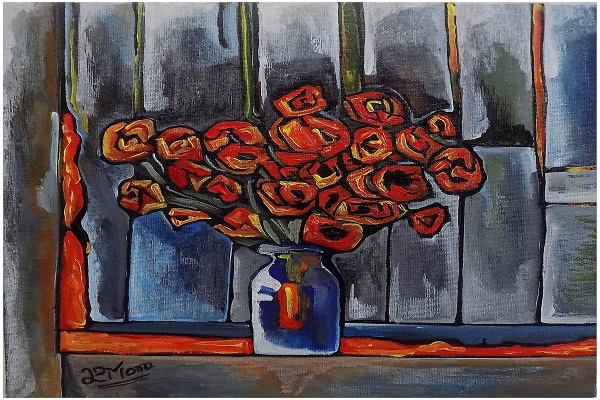
" 'Every artist was first an amateur.' - Ralph Waldo Emerson.
Have you ever wondered how to transition from an amateur artist to a successful online seller? In the increasingly digitized art market, understanding the intricacies of selling modern paintings online is no longer just a choice but a necessity for artists seeking recognition and financial success. With the traditional art scene evolving into a virtual realm, the demand for uncovering the secrets to successful online art sales is more pressing than ever. From navigating digital platforms to mastering marketing techniques, this blog delves into the dynamic world of digital art commerce, guiding you through the process of unlocking the secrets of selling modern art online.
Understanding Characteristics of Modern Art that Appeal to Online Buyers
Modern painting is characterized by its ability to defy convention, provoke thought, and stir emotions. These very qualities hold a magnetic attraction for online art enthusiasts. Here are some of the key characteristics of modern art that resonate with digital buyers:
1. Expressive Freedom
Modern art transcends traditional boundaries, allowing artists to unleash their creativity without constraints. This unrestricted expression fosters a sense of curiosity and intrigue among online buyers, who are drawn to the boundless possibilities.
2. Emotional Resonance
Modern art often elicits profound emotional responses. Its ability to communicate complex feelings and ideas in a visual language can strike a chord with viewers on a personal level. Online buyers seek this connection as art becomes a reflection of their own emotions.
3. Versatility
Modern paintings encompass a diverse array of styles, spanning from the abstract and surreal to pop art and minimalism. This broad spectrum ensures there's something to suit every individual's tastes, rendering it both accessible and relatable to a wide and varied online audience.
4. Timelessness
Modern paintings have the unique quality of transcending time. Many contemporary and modern works maintain their relevance across generations, making them a valuable addition to a collector's portfolio.
5. Visual Impact
The bold colors, striking compositions, and innovative techniques found in modern paintings can create an immediate visual impact, catching the eye of online shoppers amidst the digital noise.
Analyze Current Trends and Demands in the Modern Art Market
To truly understand the modern painting market and sell art online, it's essential to keep a finger on the pulse of current trends and demands. Various factors, including the changing preferences of art buyers and emerging artistic movements, shape this dynamic landscape. Here's a glimpse of what's currently driving the modern art market:
1. Digital Art
The emergence of digital platforms has marked the dawn of a groundbreaking era for digital art. Non-fungible tokens (NFTs) and digital collections have witnessed an extraordinary surge in popularity, fundamentally reshaping the landscape of art acquisition and sales.
2. Sustainability
In an era of heightened environmental consciousness, sustainable art practices and materials are in demand. Artists who embrace eco-friendly techniques are finding favor with buyers.
3. Diversity and Inclusion
The art world is becoming more inclusive, with a growing appreciation for art created by underrepresented groups. Online buyers seek out diversity in artists and themes.
4. Technological Integration
Augmented reality (AR) and virtual reality (VR) are increasingly used to enhance the art-buying experience online. These technologies enable buyers to visualize artworks in their own spaces before making a purchase.
Identify the Target Audience for Modern Art Online
Before you sell art online, it's crucial to identify and understand the target audience for modern paintings . This demographic can vary, but some common traits and interests include:
1. Art Enthusiasts
These are individuals with a sincere love for art who truly understand its worth and are eager to invest in pieces that deeply connect with their emotions.
2. Collectors
Art collectors, both seasoned and novice, form a significant part of the target audience. They are interested in acquiring valuable pieces for their collections.
3. Interior Designers
Professionals in interior design often source modern paintings to enhance the aesthetics of the spaces they work on. They seek art that complements the design concepts of their projects.
4. Tech-Savvy Buyers
With the digitalization of the art market, tech-savvy buyers who are comfortable navigating online platforms are a key demographic. They are open to exploring new avenues for art acquisition.

Leveraging Digital Platforms for Selling Modern Paintings
The digital realm presents a myriad of platforms designed to sell art online. From dedicated art marketplaces to social media and personal websites, artists have an array of options at their fingertips. Let's delve into the potential of these platforms:
1.Dedicated Art Marketplace
In recent years, dedicated art marketplaces like Saatchi Art, Artsy, and Artfinder, Indian Art Ideas have gained prominence. These platforms cater specifically to art enthusiasts and collectors, offering a curated space for artists to display and sell their creations. The advantage here lies in the targeted audience, with users actively seeking art. However, competition can be fierce, making it crucial to stand out.
2.Social Media Platform
Social media platforms, especially Instagram, have also become hotspots for art promotion. Artists can use visually appealing posts to engage with a broader audience and direct traffic to their sales platforms. It's an excellent way to gain exposure, particularly among younger demographics.
3.Websites and E-Commerce Platforms
Artists can establish their online presence through personal websites and e-commerce platforms. While this approach offers more autonomy, it comes with the challenge of driving traffic and building a reputation from scratch.
Tips for Creating an Engaging Art-Selling Profile
Once you've chosen a platform, optimizing your online presence becomes crucial. Here are some tips for creating an engaging art-selling profile:
1. High-Quality Imagery
Ensure that your artwork images are high-resolution, well-lit, and showcase your paintings from various angles. Potential buyers often rely on these visuals to make decisions.
2. Compelling Descriptions
Craft compelling and informative descriptions for your artwork. Share insights about your creative process, inspiration, and the story behind each piece. It can create a deeper connection with your audience.
3. Consistency
Maintain a consistent style and branding across your profile. It helps in building a recognizable and trustworthy identity.
4. Pricing Transparency
Be transparent about your pricing. It avoids any confusion and helps potential buyers understand the value of your work.
5. Engage with Your Audience
Actively engage with comments and messages from potential buyers. Building a rapport can enhance trust and lead to successful sales.

Staying Updated with Market Dynamics
In the realm of modern paintings, where innovation and creativity intertwine, staying ahead of the curve is not just an advantage but a necessity. As trends and preferences continually shift, keeping abreast of these changes becomes paramount for artists and art sellers alike. Understanding the importance of tracking market dynamics is fundamental in maintaining relevance and meeting the ever-evolving demands of online art consumers.
Keeping Abreast of Changing Trends and Preferences
The art world is a vibrant ecosystem that thrives on novelty and progression. To resonate with the contemporary audience, it is imperative to stay attuned to the shifting preferences and emerging trends within the realm of modern paintings . Whether you witness a surge in the fascination with abstract expressionism or a revival of interest in minimalistic aesthetics, staying attuned to these shifts empowers artists and sellers to adapt their offerings to align with the prevailing artistic trends. When your creations resonate with the latest styles, you can guarantee that your artworks retain their appeal and relevance to the continuously evolving tastes of art enthusiasts.
Utilizing Market Insights
Beyond simply observing trends, utilizing comprehensive market insights can provide invaluable guidance for refining art collections and optimizing sales strategies. Analyzing the performance of different styles, themes, and mediums within the modern paintings segment can offer critical insights into what resonates most with the target audience. By harnessing data-driven analytics and leveraging consumer feedback, artists and sellers can fine-tune their collections, emphasizing the types of artwork that generate the most interest and engagement. This strategic curation not only enhances the overall appeal of the collection but also increases the likelihood of successful sales in the competitive online art marketplace.
Role of Continuous Learning and Adaptation
In the dynamic landscape of the online art business, continuous learning and adaptation are indispensable for sustained success. Adhering to traditional practices without embracing the evolving nature of the digital realm can lead to stagnation and a loss of competitive edge. Embracing a culture of perpetual learning, whether through attending industry workshops, participating in online forums, or networking with fellow artists and sellers, fosters an environment of innovation and growth. By remaining open to new techniques, technologies, and market insights, artists and sellers can adapt their approaches to match the changing dynamics of the online art business, thus ensuring their continued relevance and competitiveness in the digital marketplace.

Wrapping Up
Navigating the complex terrain of selling modern paintings online demands a nuanced understanding of market dynamics and consumer preferences. By staying attuned to the ever-evolving trends in the realm of contemporary art, artists, and sellers can effectively tailor their offerings to match the current artistic zeitgeist, ensuring their artworks remain compelling and relevant to the discerning tastes of online buyers. Leveraging insightful market data enables the refinement of art collections and sales strategies. It enhances the overall appeal and resonance of the offerings within the competitive digital marketplace. Embracing a culture of continuous learning and adaptation is pivotal in maintaining a competitive edge and fostering an environment of innovation and growth crucial for long-term success in the dynamic online art business.
Are you looking for a secure and reliable platform to sell art online? Reach out to our team of experts at Indian Art Ideas for tailored guidance and comprehensive solutions.























